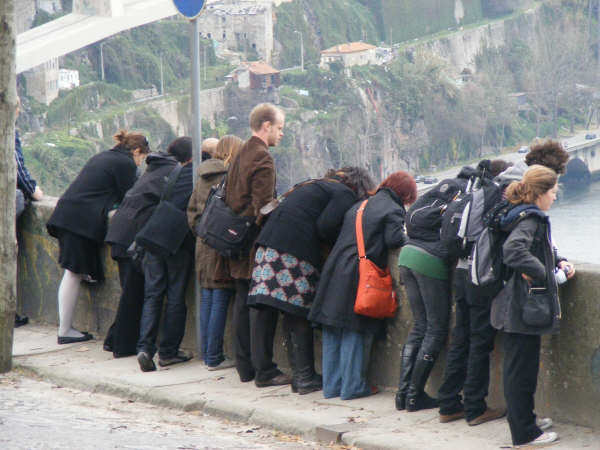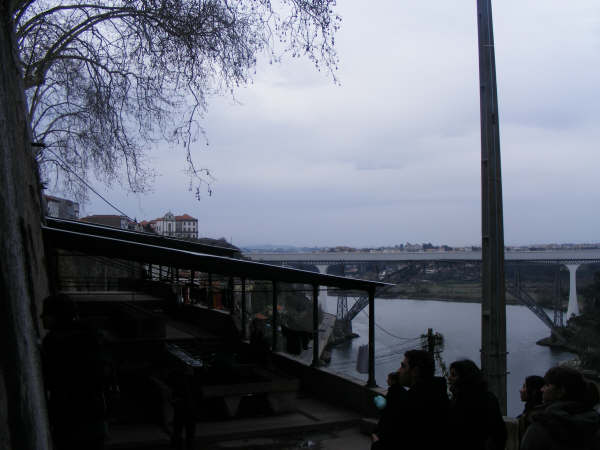First Year in Fontainhas
In mid-February, I went to Porto with three First Year units from UEL AVA’s architecture degree course. From looking at projects such as the marginal footpath from Gaia to Afurada, the ocean swimming pools at Matosinhos, or even the Ribeira communal washhouse, it could easily be surmised that the citizens of Porto enjoy an exemplary relationship to design, architecture, and urbanism. We felt that a voluntary tour of Fontainhas might prove an interesting complement to these other destinations: a chance to see some ways of life which express both beauty (of site, of social dynamism) and conflict. This dichotomy is one of the things that interests me most about Fontainhas: a delightful urban situation and at the same time a complex set of issues regarding viability, access, servicing, even human rights.

[photo: Svetlana Podoprigora]
We began in the shadow of the raised carriageway just east of Guindais. I stood on one of the Portuguese ‘love seats’, set into the low stone retaining wall and gave a brief introduction to what we would see. These love seats, it can be surmised, are a leftover from Fontainhas’ past of romanticism and leisure. We would do a promenade, a relatively aimless wander, through a place aimlessly wandered through by very few.
The idea of a bairro was easily expressed by no. 50 Corticeira, a single number (50) and a flight of stairs leading down- not to a single home but to a cluster of them, gathered around a series of small terraces, steps and courtyards.
It was remarkable to stand in the wash house beneath the Dom. Infante bridge and talk about natural springs. Some students peered into the concrete tanks with the air of public health inspectors. It was unfortunate that the facility was not being used and therefore felt a little too much like archaeology.

[photo: Svetlana Podoprigora]
We pressed on downhill, past another natural spring which wet the feet, to the Nicolau bairro. By this point I felt a little wary as the head of a large group of people wandering these intensely private, two-foot wide passageways. The overhanging front porches and doorways of homes felt a little too close, the artificial snap of digital cameras a little too regular. These latter were soon overcome by a row of barking dogs, all restrained by rope or behind fencing, all defending different properties. Without a map it would be impossible to tell which ones. A woman from above took advantage of my temporary disorientation to tell us the way out, and we squeezed through the path that follows the still-active railway line. I may have been the only one sorry that a train didn’t pass. Others were disbelieving that we were allowed to stand so close to the tracks – this was one instance of the group being regularly unsure of whether or not we should continue down a given path- the feeling of privacy, or rather of a lack of easy thoroughfare, is acute.
We climbed to the railway bridge, hemmed in by steel since its starring role in Aniki Bobo. Cameras popped at homes snugly cuddled up to the high-speed railway, gathered by the playground, and descended again via the Escadas de Aguada- another location from Aniki Bobo, which provided a good excuse to describe the area as portrayed in the film, rough grass as there is still, a place of escape from the Ribeira district. Cameras popped excitedly again as we went under the large arch supporting the railway lines above us. Again I found the scale change surprising- ruined houses revealed tiny squares of linoleum or tiling, no more than a couple of metres across but bearing all the hallmarks of a home.
I think it was universally agreed that the house cantilevered over a rock over the valley, adjacent to the tracks, was the most wanted holiday home. Some brave souls went down the steps of death beside and around it in order to take photos from below and investigate further.
It started to rain as we descended the final steps, the drop punctuated again by splashes of water across the stone steps.
David Knight
About this entry
You’re currently reading “First Year in Fontainhas,” an entry on Fontainhas Diary
- Published:
- J f, 2008 / 11:39 pm
- Category:
- correspondence
- Tags:
- davidknight, friend

No comments yet
Jump to comment form | comment rss [?] | trackback uri [?]